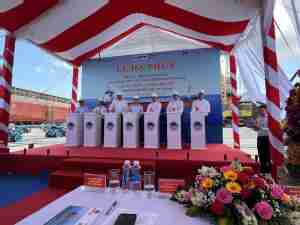US export volumes strengthened at several major ports in August, as ongoing dollar weakness boosted foreign manufacturers' demand for raw materials, port officials said.
Record trade volumes this peak holiday shipping season have not congested US ports, which have operated smoothly throughout the August-October period, port executives said. The soft US dollar continues to aid raw material exports, as foreign manufacturers jump on the exchange-rate advantage. But this trend is more than offset, in value terms, by the influx of the pricier Asian-made consumer goods that stock retailers' shelves for the holidays.
The oil import bill may not add to the trade imbalance in August vs. July. The dollar value of crude and oil-product imports fell an estimated 4.9% from July to August, according to John Felmy, chief economist at the American Petroleum Institute, a trade association for the oil and gas industry. Crude and product import prices and volume all fell, he said. The oil import bill should decrease another 12.6% from August to September, reflecting the recent plunge in oil prices, Felmy's preliminary calculations indicated.
At the nation's largest container port, Los Angeles, volumes soared in August, with imports rising more than 18% vs. August 2005 and exports vaulting 25% higher, according to port statistics.
Port spokeswoman Theresa Adams Lopez said foreign manufacturers are gobbling up American raw materials for use in costlier finished goods that often return to US shores.
"Also helping exports is the value of the US dollar," she said. The relatively weak currency makes L.A.'s outgoing freight, including waste paper, scrap metal and resins, more attractively priced.
Volumes continue to rebound from levels seen in the aftermath of labor strife and harbor congestion that snarled the port in 2004, Adams Lopez said. Through much of 2005, shippers had diverted some of their cargo away from Southern California ports, despite expanded capacity and added labor shifts. This year, Los Angeles is seeing that cargo return, and port improvements are providing a snag-free peak shipping season.
The Los Angeles-Long Beach port complex also benefits from deep channels that can accommodate the world's largest mega-freighters.
Long Beach docks booked a 10.1% gain in August imports vs. the same month last year and an 8.2% rise in exports, according to port statistics. In July, export volume had fallen almost six percent%.
"We've seen a very healthy peak season this year, which speaks to the robust economy," port spokesman John Pope said.
He, too, said the soggy US dollar adds luster to Long Beach's exported raw materials.
"We have enjoyed the weaker dollar," he said. "There's no question that that's been fueling some of the trade growth that we've been seeing."
Captain Manny Aschemeyer, executive director of the Marine Exchange of Southern California, which tracks vessel movements at four area ports, said ship arrivals have trended higher throughout 2006, as globalization produces record trade volumes. Southern California ports, convenient for Asian exporters, is the gateway to a local market of many millions of these consumers.
Farther North, in Oakland, CA, August imports rose 5.3% vs. a year ago, and exports gained 4.1% after dipping nearly eight percent in July, according to port statistics.
Port spokesman Robert Bernardo said Oakland has largely retained the diverted-cargo business it acquired beginning in 2004. And the port is preparing for an anticipated trade volume "boom" in coming years, he said, fueled in no small part by Asian economic growth. The port has just opened an office in Shanghai, and talks are underway with potential clients there, he said.
The picture is different in the Puget Sound, however. The Port of Seattle booked another month of lower volumes, with August imports off by 7.8% compared to the same month of 2005 and exports off by 4.5%, according to port statistics. Year-to-date, Sea










